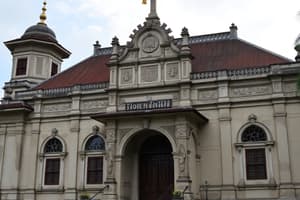Podcast
Questions and Answers
What does the term Srivijaya translate to from Sanskrit?
What does the term Srivijaya translate to from Sanskrit?
- Island Kingdom
- Great Victory (correct)
- Golden Beach
- Golden Era
Which territory was NOT part of the Kingdom of Srivijaya during its reign?
Which territory was NOT part of the Kingdom of Srivijaya during its reign?
- Java (correct)
- Sumatra
- West Kalimantan
- Coast of Malay Peninsula
What factor contributed to the decline of the Madjapahit Empire?
What factor contributed to the decline of the Madjapahit Empire?
- Natural disasters
- Piracy and the spread of Islam (correct)
- Territorial disputes within Java
- Economic isolation
Who founded the Majapahit Empire?
Who founded the Majapahit Empire?
During which century did the Srivijaya Empire reach prominence?
During which century did the Srivijaya Empire reach prominence?
What was the consequence of the Javanese accepting Islam?
What was the consequence of the Javanese accepting Islam?
What was a major challenge faced by the Madjapahit Empire in the late 15th century?
What was a major challenge faced by the Madjapahit Empire in the late 15th century?
Which area did the Madjapahit Empire expand into by 1293?
Which area did the Madjapahit Empire expand into by 1293?
What does 'suvarnabhumi' refer to in the context of India's relationship with Southeast Asia?
What does 'suvarnabhumi' refer to in the context of India's relationship with Southeast Asia?
What was one significant impact on Southeast Asia caused by the decline of Buddhism in India?
What was one significant impact on Southeast Asia caused by the decline of Buddhism in India?
During which dynasty did Chinese interaction with Southeast Asia significantly increase?
During which dynasty did Chinese interaction with Southeast Asia significantly increase?
Which products did Chinese traders primarily export during the Zhou dynasty?
Which products did Chinese traders primarily export during the Zhou dynasty?
What was the primary means of relationship between India and Southeast Asia?
What was the primary means of relationship between India and Southeast Asia?
How did Southeast Asians, particularly the Malays, contribute to the trading relationships with India?
How did Southeast Asians, particularly the Malays, contribute to the trading relationships with India?
What factor contributed to the flourishing of trade on China’s insular trade routes?
What factor contributed to the flourishing of trade on China’s insular trade routes?
What characterizes the relationship of civilizations in Southeast Asia with Chinese and Indian civilizations?
What characterizes the relationship of civilizations in Southeast Asia with Chinese and Indian civilizations?
What type of cloths were brought to Malacca by merchant ships from India?
What type of cloths were brought to Malacca by merchant ships from India?
Which of the following products was NOT brought to Malacca?
Which of the following products was NOT brought to Malacca?
What was a significant outcome of controlling the Strait of Malacca?
What was a significant outcome of controlling the Strait of Malacca?
The term 'Sailendras' is derived from which language?
The term 'Sailendras' is derived from which language?
Which of these is a reason for the weakening of the port of Kediri?
Which of these is a reason for the weakening of the port of Kediri?
What island is associated with the origin of cloves and pepper?
What island is associated with the origin of cloves and pepper?
What does 'Pagnganganga' represent in ancient Filipino culture?
What does 'Pagnganganga' represent in ancient Filipino culture?
Which item from Arabia was brought to Malacca?
Which item from Arabia was brought to Malacca?
Flashcards
What was Srivijaya?
What was Srivijaya?
Srivijaya was a powerful empire established in Insular Southeast Asia, known for its vast maritime influence and strategic location.
Why was Srivijaya's location so important?
Why was Srivijaya's location so important?
Srivijaya's strategic location in the Strait of Malacca made it a vital trade hub for maritime trade routes connecting India and China.
What does the name "Srivijaya" mean?
What does the name "Srivijaya" mean?
The word Srivijaya is derived from Sanskrit and means "Great Victory" or "Great Conquest." It highlights its importance in maritime trade and dominance in the region.
How did the Madjapahit Empire rise to power?
How did the Madjapahit Empire rise to power?
Signup and view all the flashcards
Who was the ruler of the Madjapahit Empire during its golden age?
Who was the ruler of the Madjapahit Empire during its golden age?
Signup and view all the flashcards
What factors led to the downfall of the Madjapahit Empire?
What factors led to the downfall of the Madjapahit Empire?
Signup and view all the flashcards
What was the significance of Malacca?
What was the significance of Malacca?
Signup and view all the flashcards
How did Malacca become a powerful trading hub?
How did Malacca become a powerful trading hub?
Signup and view all the flashcards
What is a 'nganga'?
What is a 'nganga'?
Signup and view all the flashcards
Indus & Shang civilizations
Indus & Shang civilizations
Signup and view all the flashcards
Trade and cultural influence
Trade and cultural influence
Signup and view all the flashcards
India's influence on Southeast Asia
India's influence on Southeast Asia
Signup and view all the flashcards
Decline of Indian Influence
Decline of Indian Influence
Signup and view all the flashcards
China's influence on Southeast Asia
China's influence on Southeast Asia
Signup and view all the flashcards
The
The
Signup and view all the flashcards
Zhou Dynasty Trade
Zhou Dynasty Trade
Signup and view all the flashcards
Malacca in the 15th Century
Malacca in the 15th Century
Signup and view all the flashcards
Strait of Malacca's significance
Strait of Malacca's significance
Signup and view all the flashcards
Spice Trade in Malacca
Spice Trade in Malacca
Signup and view all the flashcards
Textile Trade from India
Textile Trade from India
Signup and view all the flashcards
Other Trade Goods in Malacca
Other Trade Goods in Malacca
Signup and view all the flashcards
The Sailendras
The Sailendras
Signup and view all the flashcards
Sailendras - Origin of the name
Sailendras - Origin of the name
Signup and view all the flashcards
Decline of Kediri
Decline of Kediri
Signup and view all the flashcards
Study Notes
Ancient Civilizations in Insular Southeast Asia
- Islands were connected by vast seas, not roads. Boats were gateways to distant lands, cultures, and treasures.
- Srivijaya and Majapahit, powerful empires, were established in present-day Indonesia. Majapahit was the largest archipelago in the world.
- Malacca was established in present-day Malaysia.
The Srivijaya in the 7th Century
- The word Srivijaya comes from Sanskrit, meaning "Great Victory" or "Great Conquest".
- The Chinese called Srivijaya Jinzhou, which means "Golden District" or "Golden Beach" due to the kingdom's gold wealth.
- The Malay Peninsula, Sumatra, West Kalimantan, and West Java were part of Srivijaya during its reign.
The Madjapahit in the 13th Century
- The Madjapahit Empire was founded by the Kediri.
- The Kediri expanded their territories in 1293, conquering areas previously controlled by Srivijaya and other smaller kingdoms.
- Conquered territories paid tribute to the Madjapahit Empire.
The Malacca in the 15th Century
- Malacca became a trade center in the 15th century.
- Trade products from Southeast Asia and other regions (nutmeg, pepper, cloves, camphor, gold, sandalwood from Timor, various cloth types like Bengal cloth and Cambay cloth, opium, wool, hats, glass beads, metal tools, silk, satin, damask, brocade, porcelain, pearls, and silver) brought to the port of Malacca.
- Malacca controls trade between Southeast Asia, India, China, Arabia, and Europe.
- Islam spread strongly throughout the Malay Peninsula, islands of Indonesia, and even the southern part of the Philippines.
The Sailendras
- Sailendras were prominent rulers in central Java during the height of their power.
- The word Sailendras comes from Sanskrit meaning "King of the Mountains," referring to the origin of cloves and pepper in the Moluccas and nutmeg in the Banda Islands.
- The Kedri people are close to the origin in the Banda Islands.
- The port of Kediri weakened around the middle of the 13th century after a Mongol attack, destroying the Javanese government.
Relationship of the Philippines with Ancient Civilizations in Southeast Asia
- Philippines has ties to ancient civilizations, empires, or kingdoms in Southeast Asia. This relationship was established mainly through trade.
Pagnganganga
- Pagnganganga is an old Austronesian tradition, typically used for socializing, especially when guests are present.
- If the owner of a house does not engage in the tradition of paying respect to a visitor, it's considered an insult.
Relationship of Civilizations in Southeast Asia with Chinese and Indian Civilizations
- China and India are countries where earliest civilizations emerged (Indus and Shang, respectively).
- These civilizations interacted with Southeast Asian civilizations primarily through architecture, infrastructure, religion, and literature.
- India refers to Southeast Asia as "suvarnabhumi," meaning "land of gold." The spread of Hinduism was key to their relations.
- Trade was a two-way process; Southeast Asian traders also traveled to India.
- The decline in Buddhism in 12th century India and the fall of Hindu power by the arrival of the Muslims caused a decline in India's influence.
- Similar to India, China's relationship was also based on trade and commerce.
- During the Shang period, China believed it was the center of the world ("middle kingdom"). They traded various items (ivory, pearls, bird feathers) during the Zhou dynasty.
- Trade flourished between the 2nd and 15th centuries (connecting China, India, Arabia, Africa, and Europe).
Formative Assessment: Events Order
- a. Beginning of the strengthening of Srivijaya's naval forces in Southeast Asia.
- b. Expansion of the territories of the Kediris.
- d. The port in Malacca became a center of trade.
- e. Mongol invasion of Majapahit.
- c. Increased piracy in Malacca, Singapore, Madura, Penang and Aceh.
How did ancient civilizations in Insular Southeast Asia establish relationships?
- Relationships were established primarily through trade.
Studying That Suits You
Use AI to generate personalized quizzes and flashcards to suit your learning preferences.




